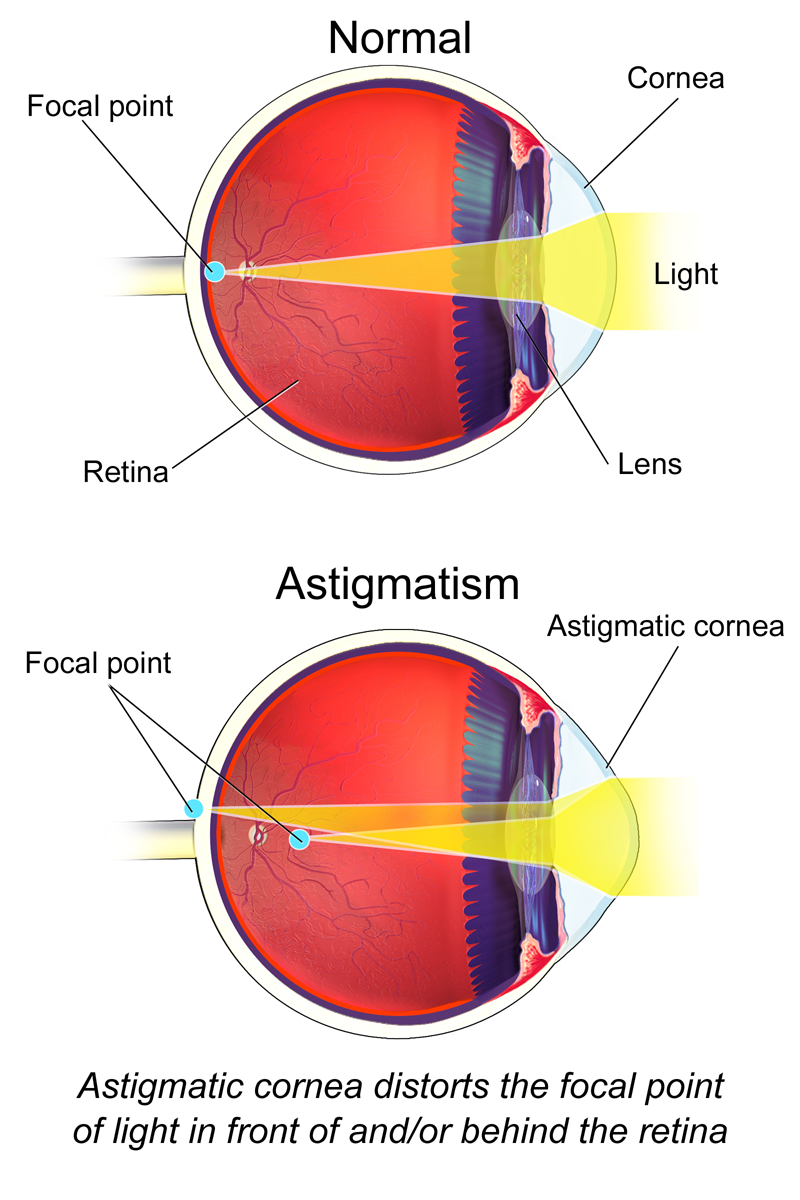Astigmatism
Astigmatism is a really annoying eye condition that means you have blur in a specific direction, or axis (technically, depending on the notation used for your prescription, the axis may indicate the angle of the eye's meridian where you have no astigmatism, and need no extra lens power, or the one where you have the most and need the most extra lens power). Astigmatism is compensated with cylinder lenses. A cylinder lens adds power along one particular meridian of the eye.
Astigmatism often reduces spontaneously as myopia is corrected.
Understanding astigmatism
Astigmatism is caused by an irregularly shaped cornea or lens. The first is called corneal astigmatism, which is the more common form, and the second is called lenticular astigmatism. It is often described as a having the cornea shaped like a rugby ball, rather than spherical like a basketball. The optics of an idealised lens of such a form would cause incoming light on different planes (corresponding to the two principal axes of the lens) to be focused at different offsets beyond the lens:
Most diagrams of lenses show only a single vertical plane. In the real world, of course, there is a full cone of light arriving on the lens from the source object. This diagram shows two different cross-sections through the incident cone of light, aligned with the two axes. Rays in the horizontal cross-section (which contains the stronger curve) are focused earlier - at the label 'T' (for 'Tangential'). The rays in the vertical cross-section (the 'Saggital') are focused further behind, at 'S'. The other rays around the light cone are focused at points in between the two, giving an image smeared out along the axis. (This is a similar sort of effect to Chromatic Aberration, where different wavelengths are focused at different distances.)
A real cornea, of course, doesn't conform to expectations. Being messier, it just has a bulge, which means that the image is not only smeared out along the axis, but is rotated, resulting in multiple (blurred) images being perceived on the retina.
Reducing astigmatism
As with myopia, astigmatism should be tackled in small steps when selecting lenses for differential or normalized glasses. If only a small amount of cylinder correction is present, say 0.25 diopters, the cylinder correction can be dropped, with no other changes. Otherwise, cylinder should be reduced in small increments. If sphere is being reduced, cylinder should not be changed at the same time, and conversely, if cylinder is being reduced then sphere should not be changed. The only time that both sphere and cylinder should be changed, is when converting to the spherical equivalent.
The spherical equivalent of cylinder lenses may be useful, to simplify the reduced lens path. 0.50 cylinder means the power varies from 0D on one axis to 0.5D on the perpendicular axis. This can be substituted by the spherical power with the averaged value of 0.25D. For example, a full prescription of "-1.00 Sphere -1.50 Cylinder" could be converted to "-1.75 Sphere". The resulting spherical equivalent is not intended to compensate for the asymmetry of the lens, so it will introduce some directional blur.
Regardless of how the myope reduces their lenses, the goal of each reduction is to have a small amount of "useful blur", to be cleared up with active focus and good habits.
Resources
- EndMyopia Blog - The Definitive Guide: What Is Astigmatism
- EndMyopia Blog - all astigmatism articles

